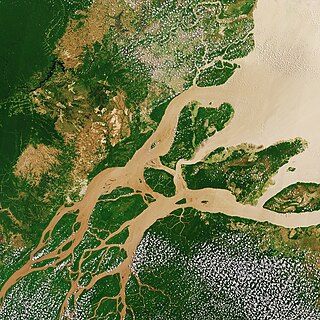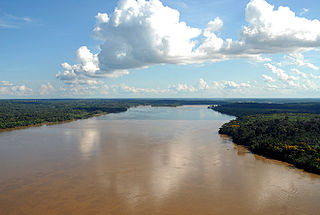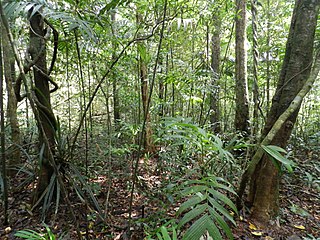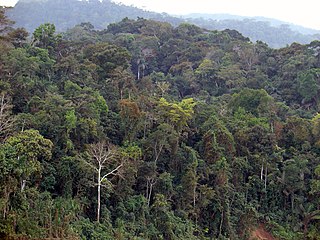Related Research Articles

The Amazon River in South America is the largest river by discharge volume of water in the world, and the longest or second-longest river system in the world, a title which is disputed with the Nile.

Deforestation or forest clearance is the removal and destruction of a forest or stand of trees from land that is then converted to non-forest use. Deforestation can involve conversion of forest land to farms, ranches, or urban use. About 31% of Earth's land surface is covered by forests at present. This is one-third less than the forest cover before the expansion of agriculture, with half of that loss occurring in the last century. Between 15 million to 18 million hectares of forest, an area the size of Bangladesh, are destroyed every year. On average 2,400 trees are cut down each minute. Estimates vary widely as to the extent of deforestation in the tropics. In 2019, nearly a third of the overall tree cover loss, or 3.8 million hectares, occurred within humid tropical primary forests. These are areas of mature rainforest that are especially important for biodiversity and carbon storage.

The Madeira River is a major waterway in South America. It is estimated to be 1,450 km (900 mi) in length, while the Madeira-Mamoré is estimated near 3,250 km (2,020 mi) or 3,380 km (2,100 mi) in length depending on the measuring party and their methods. The Madeira is the biggest tributary of the Amazon, accounting for about 15% of the water in the basin. A map from Emanuel Bowen in 1747, held by the David Rumsey Map Collection, refers to the Madeira by the pre-colonial, indigenous name Cuyari.
The River of Cuyari, called by the Portuguese Madeira or the Wood River, is formed by two great rivers, which join near its mouth. It was by this River, that the Nation of Topinambes passed into the River Amazon.

The Amazon rainforest, also called Amazon jungle or Amazonia, is a moist broadleaf tropical rainforest in the Amazon biome that covers most of the Amazon basin of South America. This basin encompasses 7,000,000 km2 (2,700,000 sq mi), of which 5,500,000 km2 (2,100,000 sq mi) are covered by the rainforest. This region includes territory belonging to nine nations and 3,344 formally acknowledged indigenous territories.

The Amazon basin is the part of South America drained by the Amazon River and its tributaries. The Amazon drainage basin covers an area of about 7,000,000 km2 (2,700,000 sq mi), or about 35.5 percent of the South American continent. It is located in the countries of Bolivia, Brazil, Colombia, Ecuador, Guyana, Peru, Suriname, and Venezuela, as well as the territory of French Guiana.

Ilo is a port city in southern Peru, with 66,118 inhabitants. It is the second largest city in the Moquegua Region and capital of the Ilo Province.
Environmental issues in Bolivia include deforestation caused by commercial agriculture, urbanization, and illegal logging, and biodiversity loss attributed to illegal wildlife trade, climate change, deforestation, and habitat destruction. Since 1990, Bolivia has experienced rapid urbanization raising concerns about air quality and water pollution.

Building blocks for tropical rainforest conservation include ecotourism and rehabilitation. Reforestation and restoration are common practices in certain areas to try to increase tropical rainforest density. By communicating with the local people living in, and around, the rainforest, conservationists can learn more about what might allow them to best focus their efforts. Rainforests are globally important to sustainability and preservation of biodiversity. Although they may vary in location and inhabited species of plants and animals, they remain important worldwide for their abundance of natural resources and for the ecosystem services. It is important to take into consideration the differing species and the biodiversity that exists across different rainforest types in order to accurately implement methods of conservation.

Peruvian Amazonia, informally known locally as the Peruvian jungle or just the jungle, is the area of the Amazon rainforest included within the country of Peru, from east of the Andes to the borders with Ecuador, Colombia, Brazil and Bolivia. This region comprises 60% of the country and is marked by a large degree of biodiversity. Peru has the second-largest portion of the Amazon rainforest after the Brazilian Amazon.
Amazon Conservation Association (ACA) is a 501(c)(3) non-profit organization working to conserve the biodiversity of the Amazon basin through the development of new scientific understanding, sustainable resource management and rational land-use policy.

Brazil once had the highest deforestation rate in the world and in 2005 still had the largest area of forest removed annually. Since 1970, over 700,000 square kilometres (270,000 sq mi) of the Amazon rainforest have been destroyed. In 2001, the Amazon was approximately 5,400,000 square kilometres (2,100,000 sq mi), which is only 87% of the Amazon's original size. According to official data, about 729,000 km² have already been deforested in the Amazon biome, which corresponds to 17% of the total. 300,000 km² have been deforested in the last 20 years.
Environmental issues in Brazil include deforestation, illegal wildlife trade, illegal poaching, air, land degradation, and water pollution caused by mining activities, wetland degradation, pesticide use and severe oil spills, among others. As the home to approximately 13% of all known species, Brazil has one of the most diverse collections of flora and fauna on the planet. Impacts from agriculture and industrialization in the country threaten this biodiversity.
John Cain Carter is a cattle rancher and conservationist who started the Brazilian rainforest conservation organization, Aliança da Terra. Carter moved to Brazil from Texas in 1996, where he and his wife managed an 8200 hectare cattle ranch between the Xingu and Amazon Rivers in the Brazilian state of Mato Grosso. Shocked by the rapid deforestation occurring in the Amazon Rainforest, Carter started Aliança da Terra to provide economic incentives for farmers and ranchers to preserve the forest land.

The Amazon rainforest, spanning an area of 3,000,000 km2, is the world's largest rainforest. It encompasses the largest and most biodiverse tropical rainforest on the planet, representing over half of all rainforests. The Amazon region includes the territories of nine nations, with Brazil containing the majority (60%), followed by Peru (13%), Colombia (10%), and smaller portions in Venezuela, Ecuador, Bolivia, Guyana, Suriname, and French Guiana.

Rates and causes of deforestation vary from region to region around the world. In 2009, two-thirds of the world's forests were located in just 10 countries: Russia, Brazil, Canada, the United States, China, Australia, the Democratic Republic of the Congo, Indonesia, India, and Peru.
An immense number of bird species live in the Amazon rainforest and river basin. Over 1,300 of these species are types of birds, which accounts for one-third of all bird species in the world. The diets of rainforest birds greatly differ between species, although, nuts, fruits and leaves are a common food for many birds in the Amazon. Birds migrate to the Amazon rainforest from the North or South. Amazon birds are threatened by deforestation since they primarily reside in the treetops. At its current rate of destruction, the rainforest will be gone in forty years. Human encroachment also negatively affects the habitat of many Amazonian birds. Agriculture and road clearings limits the habitable areas. Birds in the Amazon are distinguished by which layer of the rainforest they reside in. Each layer or community has unique plants, animals and ecosystems. Birds interact with other animals in their community through the food chain, competition, mating, altruism and symbiosis.

The Amazon biome contains the Amazon rainforest, an area of tropical rainforest, and other ecoregions that cover most of the Amazon basin and some adjacent areas to the north and east. The biome contains blackwater and whitewater flooded forest, lowland and montane terra firma forest, bamboo and palm forest, savanna, sandy heath and alpine tundra. Some areas of the biome are threatened by deforestation for timber and to make way for pasture or soybean plantations.
The Brazil–Peru Railway or Bi-Oceanic Railway is a proposed transcontinental railroad project that will link the Atlantic and Pacific Oceans via Bolivia. In 2017 it was estimated to cost € 12 billion.

The 2019 Amazon rainforest wildfires season saw a year-to-year surge in fires occurring in the Amazon rainforest and Amazon biome within Brazil, Bolivia, Paraguay, and Peru during that year's Amazonian tropical dry season. Fires normally occur around the dry season as slash-and-burn methods are used to clear the forest to make way for agriculture, livestock, logging, and mining, leading to deforestation of the Amazon rainforest. Such activity is generally illegal within these nations, but enforcement of environmental protection can be lax. The increased rates of fire counts in 2019 led to international concern about the fate of the Amazon rainforest, which is the world's largest terrestrial carbon dioxide sink and plays a significant role in mitigating global warming.
The Piripkura are an indigenous tribe who inhabit the Piripkura Indigenous Territory in Mato Grosso, Brazil. They are one of the last isolated Indigenous groups in the Amazon rainforest, with only three known survivors. Violence and deforestation have led to significant losses, with many tribe members killed by illegal loggers in the 1980s.
References
- ↑ "Li's visit to Latin America draws attention to Twin Ocean Railroad Connection project". People's Daily. 22 May 2015. Retrieved 26 May 2015.
- 1 2 "The Trans-Amazonian Rail, China's latest venture in South America". www.midnight-trains.com. Retrieved 2024-01-12.
- ↑ Watts, Jonathan (16 May 2015). "China's Amazonian railway 'threatens uncontacted tribes' and the rainforest". The Guardian. Retrieved 26 May 2015.
- ↑ "China, Brazil, Peru Eye Transcontinental Railway Megaproject". International Business Times. 19 May 2015. Retrieved 26 May 2015.
- 1 2 "Brazil–Peru Transcontinental Railway". The People's Map of Global China. Retrieved 2024-01-12.
- ↑ "Final Report Vol. 4 (With Comments from Brazil).pdf". Google Docs. Retrieved 2024-01-12.
- ↑ https://www.planalto.gov.br/ccivil_03/_Ato2007-2010/2008/Lei/L11772.htm
- ↑ International, Survival. "'Deadly' trans-Amazon railway sparks fear among tribes". www.survivalinternational.org. Retrieved 2024-01-12.
- ↑ "Brazil's military takes on illegal loggers to protect nearly-extinct tribe". Mongabay Environmental News. 2013-07-18. Retrieved 2024-01-12.
- ↑ "'Deadly' trans-Amazon railway sparks fear among rainforest tribes". theecologist.org. 2015-06-16. Retrieved 2024-01-12.
- ↑ Barber, Christopher P.; Cochrane, Mark A.; Souza, Carlos M.; Laurance, William F. (2014-09-01). "Roads, deforestation, and the mitigating effect of protected areas in the Amazon". Biological Conservation. 177: 203–209. Bibcode:2014BCons.177..203B. doi:10.1016/j.biocon.2014.07.004. ISSN 0006-3207.
- ↑ Bicknell, Jake (2015-06-19). "China's Trans-Amazonian railway might be the lesser of two evils". The Conversation. Retrieved 2024-01-12.
- ↑ "Brazil, Peru and China and the Inter-oceanic Dream". 2022-04-05. Archived from the original on 2022-04-05. Retrieved 2024-01-12.
- ↑ "China lifts Brazilian beef import ban ahead of Lula's visit". Al Jazeera. Retrieved 2024-01-12.
- ↑ West, Thales A. P.; Rausch, Lisa; Munger, Jacob; Gibbs, Holly K. (November 2022). "Protected areas still used to produce Brazil's cattle". Conservation Letters. 15 (6). Bibcode:2022ConL...15E2916W. doi:10.1111/conl.12916. ISSN 1755-263X.
- ↑ "Deforestation Linked to Agriculture | Global Forest Review". research.wri.org. Retrieved 2024-01-12.
- ↑ "Project Amazonia: Threats - Agriculture and Cattle Ranching". web.mit.edu. Retrieved 2024-01-12.